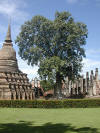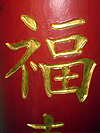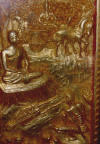|
fakir
A Muslim who has taken a vow of
poverty. In Muslim countries usually a hermit who does penance, lives
from alms and chastises himself. The term is however often wrongly used
for yogis who perform supernatural acts.

fang kong qian (方孔钱)
Chinese. 'Square hole coin'.
Name for ancient Chinese coins with a round shape and a square hole in
the middle. They are cast rather than stamped and made from copper,
brass or iron. The shape is symbolic with the round outside representing
Heaven and the square hole in the center representing Earth or the
country China, referring to guo (国), the Chinese character for
'country', that equally is surrounded by a square. Different kinds of
this type of coin were used in China between the 2nd Century BC and 20th
Century AD. The hole enables the coins to be strung together to create a
higher value and for easy transportation. This practice continues still
today with yasui qian, worn for protection against sickness and death.


Fan Li
(范蠡)
Name for the Chinese god of
business who is also a civilian Chinese wealth god. Legend has it that
he was an important figure in the Spring and Autumn Period (ca. 770 BC
to 403 BC), a distinguished politician, strategist and a money-making
businessman who was also very gifted and wise. He was honored as an
excellent minister for governing the country and for helping King
Goujian put together and train an army. He accumulated great wealth of
which he distributed much to the people and thus became a Cai Shen.

feng (蜂)
Chinese for 'wasp' or 'bee'. It
has the same sound and tone as the word feng (丰) which means 'abundant'
or 'plentiful', but is written with a different character. Hence wasps
and bees are regarded a symbol for abundance.

_small.JPG)
fenghuang (凤凰)
Chinese name for a kind of a
mythical bird similar to a phoenix. Fenghuang is actually a compound
word, comparable to kilen. The prefix feng refers to a male species
whereas the suffix huang refers to the female. Both have become blurred
into a single entity with no distinction of gender, having both male and
female connotations. It is a composition of many birds and is often
portrayed with the head of a golden pheasant, a short hooked beak like
that of a parrot, the body of a mandarin duck, the legs of a crane bird,
the tail of a peacock and the wings of a swallow. Fenghuang is
considered an Immortal Bird and a representation of high merit and
grace. It also symbolizes the union of yin and yang. In Thailand it is
compared to the hongse.


feng shui (风水)
Chinese. 'Wind and water'.
Natural elements of wind and water used in a geomantic system which
determines the orientation of dwellings, cities, and graves in order to
harmonize correctly with nature. A dousing rod and astrological compass
(luopan) are used for this purpose which is also practiced in
contemporary oriental architecture.

fen
tao (分桃)
Chinese. 'To divide a peach'.
The term originates from the story of Mizi Xia, the boyfriend of the
ruler of Wei, who one day, when strolling in a peach orchard gave half
of a sweet peach to his lover to enjoy. Besides this the peach is the
symbol of immortality and eternal live. In Pinyin fēn táo. It is
nowadays the vernacular expression for 'gay' or 'homosexual'. Other
related expressions include long yang, nan feng, duan xiu and nan se.

ficus religiosa
Latin. Scientific name for the
'tree of knowledge', also known as a bodhi tree due to the narrative of
Siddhartha Gautama who sat beneath a ficus religiosa in Bodh Gaya, to
meditate until he gained Enlightenment or bodhiyan, and thus became the
Buddha. The leaves of the ficus religiosa resemble the shape of a lotus,
a metaphor for Enlightenment and thus a clear reference. After the
original tree was cut in 600 AD, cuttings were replanted wherever
Theravada Buddhism was introduced and practiced. In literature often
confused with the banyan tree, the tree to which the Buddha moved to
stay, seven days after he had gained Enlightenment.


First
Buddha
The supreme primordial Buddha
in the Vajrayana sect of Mahayana Budhhism, who created himself from the
original void. In true essence this Buddha is abstract, illusionary and
inconceivable, and can therefore not be represented in art, unless in
his revealed and more earthly forms such as Vajradhara and Vajrasattva,
as found in Khmer art, and the various bodhisatvas. Vairochana is
considered the Javan Adi-Buddha. Usually depicted in royal attire or in
hermaphrodite unity with a consort, a principle in Vajrayana Buddhism
known as yabyum. Also Adi-Buddha.

First Noble Truth
See
Four Noble Truths.

foo (福)
Chinese. 'Blessing', 'good
luck' and 'happiness', especially with regards to material benefits. Foo
is one of the most popular Chinese characters and is used in Chinese New
Year or Trut Jihn. It regularly appears as an imprint or as an
inscription on Chinese temples and in art, or as a jewel. It is also
often posted upside-down on the front door of a house or an apartment.
The upside-down foo means good luck already came, since the character
for 'upside-down' in Chinese sounds the same as the Chinese character
for 'came'. Foo is also one of the Three Star Gods, Hok Lok Siw or Fu Lu
Shou, and is often worshipped as an informal Chinese wealth god. The
word fu also has a sound loan word meaning 'bat', the mouse-like
nocturnal flying mammal. Therefore also the bat has become a symbol for
good luck and often appears in Chinese iconography as well as in Chinese
art. Also transcribed fu and in Cantonese pronounced fuk. The Chinese
name of the coastal province of Fujian (福建) in eastern China begins with
the character fu (foo) and translates as 'Establishing Good Luck' or
'Founding Happiness'.


Four Encounters
The four sights encountered by
prince Siddhartha which made him renounce his royal life and become an
ascetic. In Theravada Buddhism these are an old man, a sick man, a dead
body and a mendicant ascetic who went around begging without any form of
attachment or hate, and with inner peace. Attracted by the qualities of
this monk and the condition of the three others Siddhartha eventually
exchanges his princely life for a religious one.


Four Noble Truths
The fundamentals of Buddhism as
taught by the Buddha. The first noble truth is the recognition that
suffering exists; secondly, that suffering is caused by the craving for
and clinging to that which is pleasant; thirdly, that after discovering
the origin of suffering one can put an end to it; and fourthly, that
this can be done by following the
Eightfold Path.

fowl bone prognostication
Ritual in which the outcome of
certain events are interpreted by reading the bones of a fowl. It is
usually practiced by a shaman and the fowl used may be a chicken, hen,
cock or even a small chick, depending on the occasion or function. In
Thailand it is still common practice with most of the northern hill
tribes. Prior to the prognostication the shaman will conduct an
invocation. He holds the fowl with his left hand and his right hand
holds the neck facing eastwards while reciting his oaths. After the
incantation he kills the fowl, takes out the thighbones and pricks them
with tiny pointed bamboo sticks. The right thighbone is extracted first
and then the left one. They are then place next to each other and
pricked with the bamboo sticks which position in relation to each other
can than be read. Fowl bone prognostication is practiced since ancient
times for settling discords, for guidance about certain major works, for
hunting, in family affairs and for religious functions. A single bone
can retain as many as seven sticks and the interpretation is rather
complex. There are a total of 42 symbols that can branch off into
various interpretations and a versed shaman has as much as 170
interpretations. According to Kayan lore the art of fowl bone
prognostication started when an old man who wished to pass his legacy to
his three sons earmarked a golden scroll for his firstborn, a silver
scroll for the second son and a scroll of parchment for the youngest
son. Since the oldest son lived far away and didn't come to collect his
scroll as he was unaware of it, the youngest son took it over to him on
his hill farm. On arrival he tried to explain about the scrolls but his
brother was too busy to take heed and told him to wait. The youngest son
grew bored of waiting and decided to keep the golden scroll for himself.
He left the parchment scroll on a tree stump and returned home. After
work the oldest son went looking for the scroll but couldn't find it and
so asked his dog. It said it had eaten it and already dropped it as
excrement. The man asked where it had dropped it and the dog said that a
fowl had already eaten it. The man went to the fowl and asked the fowl
where the excrement of the dog was. The fowl said it had been
assimilated and it was now in its body, pointing with its wing tips to
its thighbones. At the last resort the man had to read the bones of the
fowl that had eaten the dung of the dog, interpreting the holes in them
as if he was reading the script of the scroll.

%202_small.jpg)
fu (福)
See
foo.

fu (蝠)
Chinese 'bat'. Since the word
fú means both 'bat' (the mouse-like nocturnal flying mammal) and 'good
luck', the bat has become a symbol for good luck and therefore often
appears in Chinese iconography, as well as on furniture and in Chinese
art. See also
foo.

Fu Lu Shou (福禄寿)
Chinese names for Hok Lok Siw.
 |